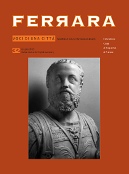New proposals for "Kairos and Metanoia" by Girolamo da Carpi.
The eighteenth century "Dresden sale" resulted in many important Ferrara artworks ending up in Dresden. One of these was a 1541 painting made by Girolamo da Carpi for the court of the house of Este and now hanging in the Gemäldegalerie in Dresden. Against a broad background shown under a menacing sky, we can see a male and a female figure, both dressed in the attire of old. He has winged feet just about resting on a sphere and his right hand is raised, holding a razor. His blonde, curly tresses are swept forward by a strong wind. She faces away. Her blond, wavy hair tumbles out from beneath a white veil, but she gazes downwards, standing mostly in his shadow and her face is etched with misery. The meaning of this scene is not easy to decipher, rendered more difficult by the fact that the painting is not intact, and is the sophisticated product of a culture that took pleasure in cloaking the meaning of words, stories and objects in a series of different layers. The work is called Kairos e Penitentia: the young man in the picture has been identified as opportunity since Vasari's time, or its Greek, male equivalent, Kairos, referring to the opportunity that needs to be seized, that is "by a tuft of hair", since the nape of the neck is shaved by the razor. The angry background refers to fate since the word also means "storm". The companion of Kairos is generally viewed as patience, but Wittkower sees her as Repentance. The themes of the painting refer to rare ancient sources, more widely known through catalogues or collections than they are in the original: Lilio Gregorio Giraldi, author of the mythological treatise De deis gentium excelled at creating these types of anthologies and is considered to be the main source behind interpretation of the symbology in Girolamo da Carpi's painting. However we know that Lilio depended on other authors in this case, especially Erasmus of Rotterdam and his Adagia. In fact the mystery of the painting links Erasmus of Rotterdam with Ferrara culture in the fifteen hundreds. Ferrara in the fifteen hundreds was the place that Erasmus followers liked best in Italy, a type of "first Erasmus city" since the message of Erasmus had made the transition from written word to art form in some Ferrara buildings.
but Wittkower sees her as Repentance. The themes of the painting refer to rare ancient sources, more widely known through catalogues or collections than they are in the original: Lilio Gregorio Giraldi, author of the mythological treatise De deis gentium excelled at creating these types of anthologies and is considered to be the main source behind interpretation of the symbology in Girolamo da Carpi's painting. However we know that Lilio depended on other authors in this case, especially Erasmus of Rotterdam and his Adagia. In fact the mystery of the painting links Erasmus of Rotterdam with Ferrara culture in the fifteen hundreds. Ferrara in the fifteen hundreds was the place that Erasmus followers liked best in Italy, a type of "first Erasmus city" since the message of Erasmus had made the transition from written word to art form in some Ferrara buildings.
They are two buildings that have marble tablets inscribed with sentences taken from the Adagia by Erasmus of Rotterdam on their front walls and carry the signature of Girolamo da Carpi, architect: the Naselli-Crispi (by 1537) and the Contughi-Gulinellli (1542). The Adagia, a huge collection of proverbs, expressions and famous sayings was first printed in Paris in 1500. Erasmus had a new expanded edition printed in 1508. Six years later a twin collection was published in Ferrara. One of the adages in the Ferrara edition refers to the invitation to 'seize the opportunity' since Kairos is a transient god. In the Basel edition of 1515, this adage was extended by citations from rare old sources, in accordance with which the intriguing, veiled young woman could be interpreted as Metanoia which is the cultured personification of Repentance in Greek. Duke Ercole II is generally attributed with having commissioned the painting, but I would like to make a new proposal. Displaying an awareness of the works of Erasmus was not without its risks, and in fact his works were later banned. The duke wouldn't have gained any advantages by taking a pro-Erasmus stance, in fact, on the contrary, it could have been dangerous and he was always at pains to show his alle
(1542). The Adagia, a huge collection of proverbs, expressions and famous sayings was first printed in Paris in 1500. Erasmus had a new expanded edition printed in 1508. Six years later a twin collection was published in Ferrara. One of the adages in the Ferrara edition refers to the invitation to 'seize the opportunity' since Kairos is a transient god. In the Basel edition of 1515, this adage was extended by citations from rare old sources, in accordance with which the intriguing, veiled young woman could be interpreted as Metanoia which is the cultured personification of Repentance in Greek. Duke Ercole II is generally attributed with having commissioned the painting, but I would like to make a new proposal. Displaying an awareness of the works of Erasmus was not without its risks, and in fact his works were later banned. The duke wouldn't have gained any advantages by taking a pro-Erasmus stance, in fact, on the contrary, it could have been dangerous and he was always at pains to show his alle giance to the church of Rome. However, at the court of Ferrara, the Duchess Renée of France was not afraid of the consequences of supporting the ideas of Erasmus. The idea that an intellectual accomplice would prepare a work of art inspired by Erasmus and then have it painted by an artist who was close to the Erasmusloving élite of Ferrara would have been an initiative worthy of the duchess and in keeping with her ideas. Thereafter, it is possible that having been taken from Renee, the narrative balance of the painting could have been altered by trimming it, softly moulding it into a new interpretation, and then it may have been placed in an environment where its association with other works with different emphases would change its significance and effect.
giance to the church of Rome. However, at the court of Ferrara, the Duchess Renée of France was not afraid of the consequences of supporting the ideas of Erasmus. The idea that an intellectual accomplice would prepare a work of art inspired by Erasmus and then have it painted by an artist who was close to the Erasmusloving élite of Ferrara would have been an initiative worthy of the duchess and in keeping with her ideas. Thereafter, it is possible that having been taken from Renee, the narrative balance of the painting could have been altered by trimming it, softly moulding it into a new interpretation, and then it may have been placed in an environment where its association with other works with different emphases would change its significance and effect.








